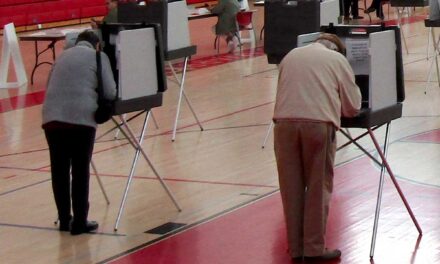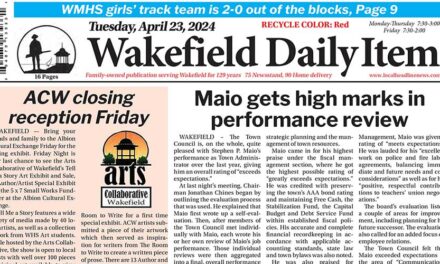Published in the November 20, 2015 edition.
By MARK SARDELLA
WAKEFIELD — Town Meeting wrapped up business last night but it took nearly four hours to get through the four remaining articles on the warrant.
Despite an impassioned plea by DPW Director Richard Stinson, there will be no return to Wakefield’s previous winter-long parking ban.
By a narrow margin of nine votes last night, Town Meeting defeated Charles McCauley’s attempt under Article 10 to effectively reinstate a ban on overnight parking on Wakefield streets from Dec. 1 to April 1. After last winter, the Board of Selectmen had eliminated the winter-long parking ban that had been in effect for decades in favor of more of a storm-by-storm approach, with residents being notified via various means including Reverse 911, social media, the town website and news media.
Under Article 10, McCauley, of Lawrence Street, filed a citizens petition to create a new bylaw that would ban overnight parking in town from 1 a.m. to 6 a.m. in the winter months.
McCauley argued that not everyone was tied into systems like Reverse 911 and social media. He said that in the winter, the DPW “needs all the help the town can give them” to clear the streets and keep them clear. He also worried about the ability of emergency vehicles to get down streets if parked cars are complicating a storm condition.
Several speakers from the floor argued against bringing back the parking ban, noting that households have more cars today than they did when the ban was first instituted in the 1960s. Weather forecasting can predict storms in plenty of time for people to get their cars off the street, was another argument.
But others supported a return to the winter-long ban, insisting that a storm-by-storm system would lead to “chaos” and result in streets that are not cleared as well as they should be.
Police Chief Rick Smith favored the new system, saying that on a clear, dry winter night people should not have to move their cars off the street.
Stinson cited his 27 years of experience in snow and ice removal. He cited a number of surrounding towns that have retained a winter long parking ban. He cited the difficulty of locating vehicle owners and getting them to move cars in the middle of the night during a snow emergency.
He feared that the new system would mean more parked cars interfering with plowing operations and increased costs from plows having to return to streets blocked by cars. Snow and ice would freeze in places the DPW could not reach due to parked cars, he said, increasing hazardous conditions.
In the end, Article 10 failed to carry with 122 voting “no” and 113 voting “yes.”
Town Planner Paul Reavis presented Article 11, which he said was designed to get an illegal bylaw off the books and at the same time encourage developers to pursue “open space subdivisions.” Such subdivisions allow a developer to place houses closer together on smaller lots in order to preserve a greater amount of common open space within the subdivision.
He said that a bylaw that many towns, including Wakefield, had adopted in 2000 required developers to submit an open space plan when applying to create a subdivision and to set aside 40 percent of the total land area as open space.
But he said that in 2008, a Massachusetts court had struck down such requirements as illegal when a developer might well be able to meet the requirements for a standard subdivision.
Article 11, he said, would make submitting an open space subdivision plan optional and reduce the amount of open space a developer must set aside to 25 percent as an incentive to pursue such a plan.
Article 11 passed 168-10, easily surpassing the required two-thirds majority required for zoning articles.
Article 12 was another zoning measure aimed at streamlining zoning in order to encourage mixed-use, multifamily development in business and industrial zones within 2,500 feet of public transit lines. Reavis said that the goal was to increase the amount of residential above retail uses and return to a more walkable downtown area.
Under Article 12 the bylaw would be amended to reduce the amount of square footage of land area needed – both overall and per unit – in an effort to encourage mixed use developments where allowed.
Ami Wall of Elm Street said that the downtown needed “serious help” and the bylaw change was “a way to revitalize the downtown.”
Bronwyn Della-Volpe of Cyrus Street opposed Article 12, saying that she was concerned about the increased density that the changes would cause and maintaining that the reductions in land area requirements were too drastic.
Thomas Bergendahl of Plymouth Road said that he thought that the concept as presented was “a little bit too big” and that there hadn’t been enough input from residents.
Bob Mitchell of Spaulding Street offered an amendment to limit the changes to certain streets but the amendment was defeated by a wide margin.
Article 12 finally carried by a vote of 123-41, clearing the two-thirds threshold of 110 by 13 votes.
The final article on the warrant, Article 13, sought to change the zoning of a small parcel of land off New Salem Street abutting both the residential and industrial districts. The owners, the Luciani family, wanted to rezone it from residential to industrial so that it could be used in conjunction with an adjacent, larger parcel that they own in the industrial district.
Representing the Luciani family, Attorney Phil Posner said that the residential-zoned parcel in question was “landlocked” with no frontage on any street and was therefore unusable unless rezoned.
After a brief discussion, Article 13 carried 107-11.
Board of Selectman chairman Ann Santos moved to dissolve the 2015 Regular Town Meeting at 10:45 p.m.
Attendance at last night’s Town meeting was 175 when Town Moderator William Carroll gaveled the meeting open at 7 p.m. By 10 p.m., 258 voters were in attendance, according to Town Clerk Rose Morgan.




